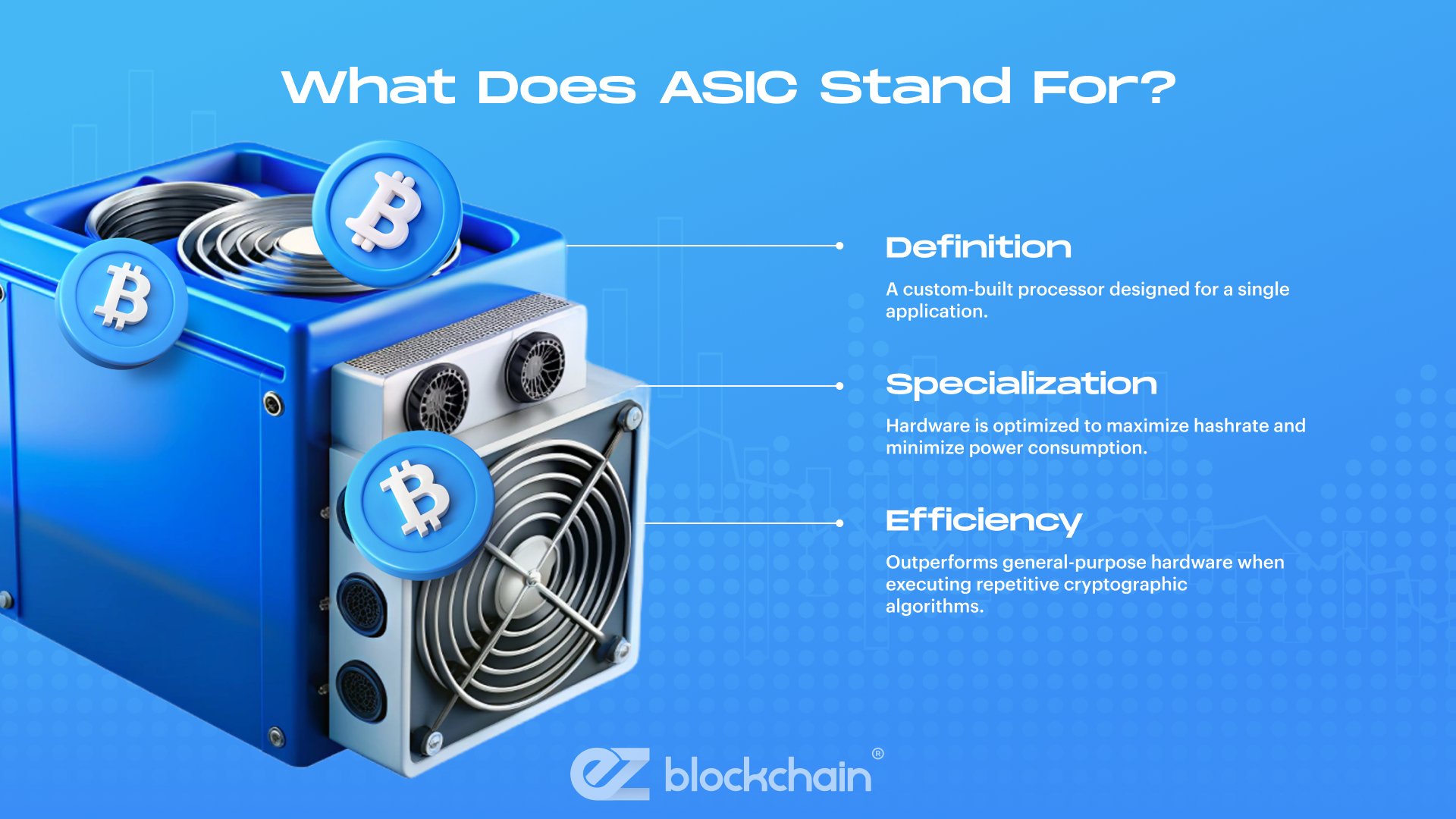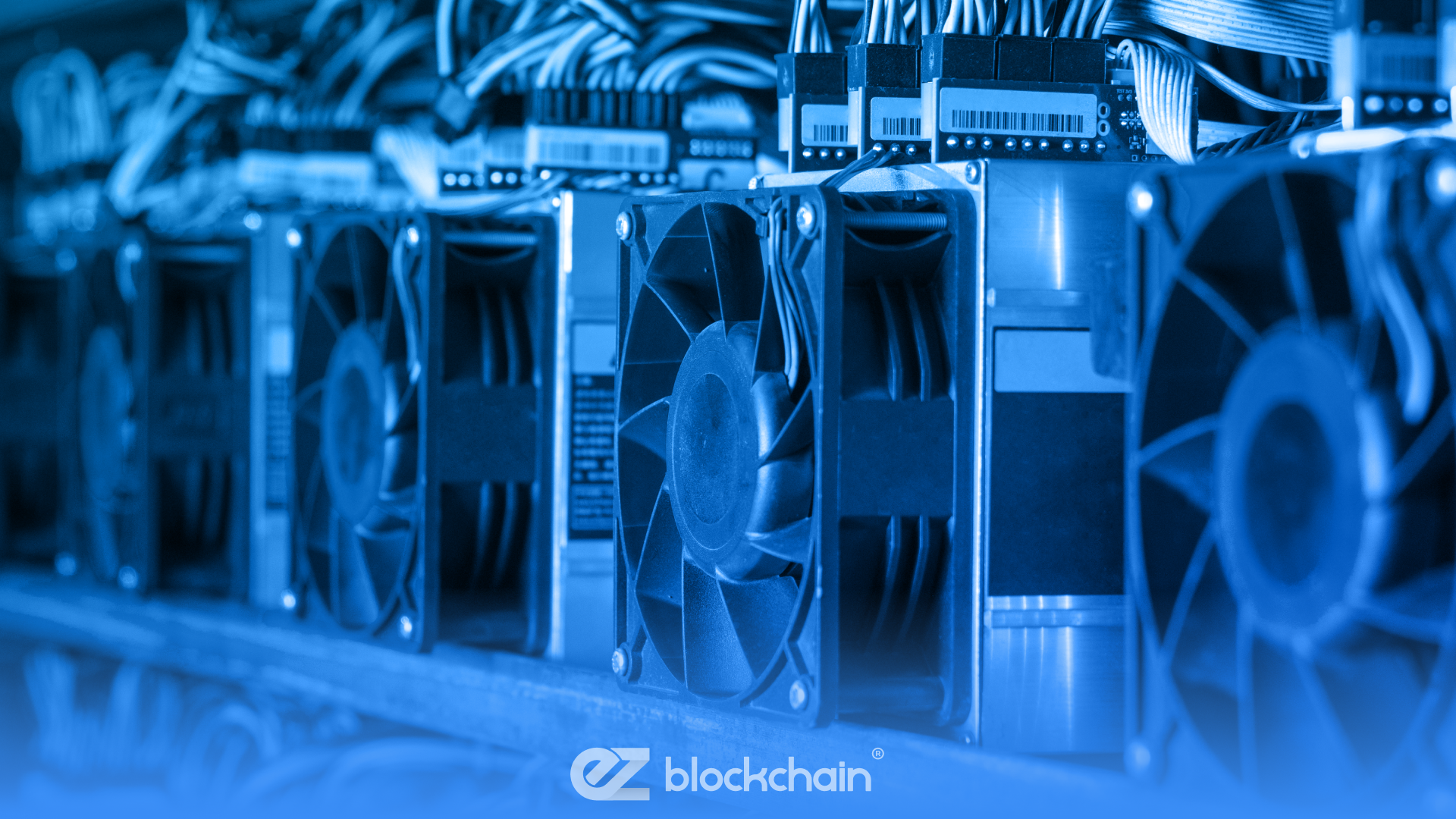Stay up to date with the latest news, announcements, and articles.
The design of ASICs enables them to process vast amounts of data with minimal power consumption, making them the preferred choice for large-scale mining operations seeking to maximize profitability. The efficiency of ASICs is not solely measured by their computational power but also by their energy consumption. Mining efficiency refers to the amount of computational work a system performs per unit of energy consumed. ASICs are engineered to optimize this ratio, resulting in lower operating costs and higher profitability compared to other hardware options.
What Does ASIC Stand For?
In the question of what is ASIC, it stands for Application-Specific Integrated Circuit. Unlike CPUs or GPUs that can handle a wide variety of tasks, ASICs are optimized for one specific application. In cryptocurrency mining, this means processing hashing algorithms with unparalleled efficiency.
- Definition: A custom-built processor designed for a single application.
- Specialization: Hardware is optimized to maximize hashrate and minimize power consumption.
- Efficiency: Outperforms general-purpose hardware when executing repetitive cryptographic algorithms.
“ASICs embody specialization: their design sacrifices versatility to achieve
unprecedented performance for targeted tasks [2].”
The emphasis on specialization in ASIC design reflects a broader trend in technology where tailored solutions are developed to meet specific needs. While this approach can lead to significant advancements in efficiency and capability within a particular domain, it also raises questions about flexibility and future-proofing.

As demands evolve and new challenges arise, the ability to adapt existing hardware becomes increasingly important. Therefore, while ASICs represent a pinnacle of performance optimization for their intended tasks, their lack of versatility underscores the ongoing balance engineers must strike between specialization and adaptability in hardware development.
How ASICs Differ from General-Purpose Hardware (e.g., CPUs and GPUs)
What is an ASIC device? While CPUs and GPUs provide flexibility, ASICs provide raw performance.
- CPUs: General-purpose, versatile processors.
- GPUs: Parallel computing power, suitable for graphics and some mining.
- ASICs: Purpose-built for maximum efficiency in one algorithm.
Advantages:
- Higher hashrates.
- Lower energy consumption per calculation.
- Longer lifespan in specific applications.
Disadvantages:
- Cannot be repurposed for non-targeted tasks.
- High upfront investment costs.
In summary, ASICs stand out from general-purpose hardware by delivering unmatched efficiency and performance for specialized tasks, particularly in cryptocurrency mining. While CPUs and GPUs offer versatility and broader application, ASICs achieve higher hashrates, lower energy consumption, and optimized longevity within their intended function.
However, this performance comes at the cost of flexibility, as ASICs cannot be repurposed for other tasks, and they often require significant upfront investment. For industries and individuals prioritizing speed, efficiency, and profitability in specific operations, ASICs remain the preferred choice, highlighting the trade-off between specialization and adaptability in modern computing.
How ASICs Work
ASIC miners are designed to solve cryptographic puzzles (hashes) more efficiently than general-purpose hardware.
Algorithm-Specific Design: Circuits are hardwired to execute SHA-256 (Bitcoin) or other algorithms.
Hashrate Performance: Measured in terahashes per second (TH/s).
Power Optimization: Lowers electricity cost per unit of computation.
“Hashrate and power efficiency remain the two defining metrics of ASIC miner
performance, determining ROI for investors [3].”
For instance, the Bitmain Antminer S19 Pro+ Hydro, with a hashrate of 191 TH/s and power consumption of 5,445 watts, offers a balance between performance and energy use. Calculations suggest a daily profit of approximately $9.04, leading to an estimated ROI of around 9 months, depending on electricity costs and cryptocurrency market conditions .
Such evaluations underscore the importance of optimizing both hashrate and power efficiency to enhance profitability. Investors must consider these factors, alongside initial investment and operational expenses, to make informed decisions in the dynamic landscape of cryptocurrency mining.
Why ASICs Are Popular in Cryptocurrency Mining
- Profitability: High efficiency translates into better margins.
- Security Contribution: Strengthens blockchain integrity by sustaining proof-of-work.
- Scalability: ASIC farms can achieve massive hashrates.
In Bitcoin, ASICs dominate because no other hardware achieves comparable profitability.
The Evolution of ASIC Technology
ASICs evolved rapidly from early designs:
- 2013: First Bitcoin ASICs appeared, replacing GPU dominance.
- 2016–2019: Generational improvements increased efficiency by 50–70% per release.
- 2020 onward: Focus shifted to energy optimization, cooling, and sustainability.

Choosing the Right ASIC Miner
When selecting mining hardware, key considerations include:
- Hashrate: Determines how many calculations per second the device can perform.
- Power Consumption: Measured in watts; directly impacts profitability.
- Cooling Requirements: Air, liquid, or immersion cooling for optimized performance.
- Initial Investment: Cost of purchase, setup, and supporting infrastructure.
- Profitability Calculators: Tools like the ASIC mining profitability calculator help determine ROI.
Challenges and Limitations of ASICs
- High Initial Costs and Maintenance
- Expensive upfront investment.
- Requires maintenance and sometimes specialized facilities.
ASICs demand significant upfront capital, often costing thousands of dollars per unit, which can be prohibitive for small-scale miners. Beyond the initial purchase, ASICs require ongoing maintenance, including hardware monitoring, firmware updates, and occasional repairs to prevent downtime. Specialized facilities, such as climate-controlled rooms or immersion cooling systems, may also be necessary to maintain optimal performance and prolong the lifespan of the devices.
Centralization Concerns in Mining Pools
- Concentration of ASIC miner hardware in large pools raises questions of network decentralization.
- Regulatory and market risks may arise from geographic clustering of miners.
Because ASICs are costly and specialized, many individual miners join large mining pools to increase their chances of earning rewards. This concentration of mining power can undermine the decentralized nature of blockchain networks, making them more susceptible to coordinated attacks or collusion. Geographic clustering of miners, often in regions with cheap electricity, can also expose the network to regulatory and political risks, potentially affecting global stability and accessibility of the blockchain ecosystem.
Ready to Start Mining? Choose EZ Blockchain
EZ Blockchain provides access to advanced miner hardware ASIC solutions with optimized efficiency. Whether you are calculating profitability or scaling your mining operation, their expertise ensures tailored mining strategies for maximum ROI.
| Feature | CPU | GPU | ASIC |
| Purpose | General computing | Graphics, parallel tasks | Single-task optimization |
| Efficiency | Low | Medium | Very high |
| Hashrate | <0.1 TH/s | 0.1–1 TH/s | 100+ TH/s |
| Power Consumption | High per hashrate unit | Moderate | Lowest per hashrate unit |
| Flexibility | Very high | High | None |
| Profitability | Very low | Low | High |
In conclusion, EZ Blockchain offers a streamlined path for both novice and experienced miners to enter the cryptocurrency mining space with confidence. What is an ASIC machine provided by EZ Blockchain? By providing access to high-performance ASIC hardware, miners benefit from unparalleled efficiency, high hashrates, and optimized power consumption, all critical factors for maximizing profitability in an increasingly competitive landscape.
When comparing mining hardware, the differences between CPUs, GPUs, and ASICs are stark. While CPUs and GPUs offer flexibility for general computing or parallel tasks, ASICs are purpose-built for a single algorithm, delivering superior efficiency and returns. For those aiming to scale operations or achieve consistent ROI, leveraging specialized ASIC miners through platforms like EZ Blockchain ensures that mining remains both technologically effective and economically rewarding.
Conclusion
ASICs represent the pinnacle of efficiency in blockchain mining. While challenges like centralization and high upfront costs remain, their role in securing cryptocurrency ecosystems is undeniable. By focusing on hardware optimization, performance, and profitability, ASICs continue to push the boundaries of what ASIC mining hardware can achieve.
Fill out a form and our bitcoin mining expert will contact you.
FREE CONSULTATIONchoose
a miner
profit and
understand data?
business remotely
with EZ Blockchain?
Fill out a form and our bitcoin mining expert will contact you.









